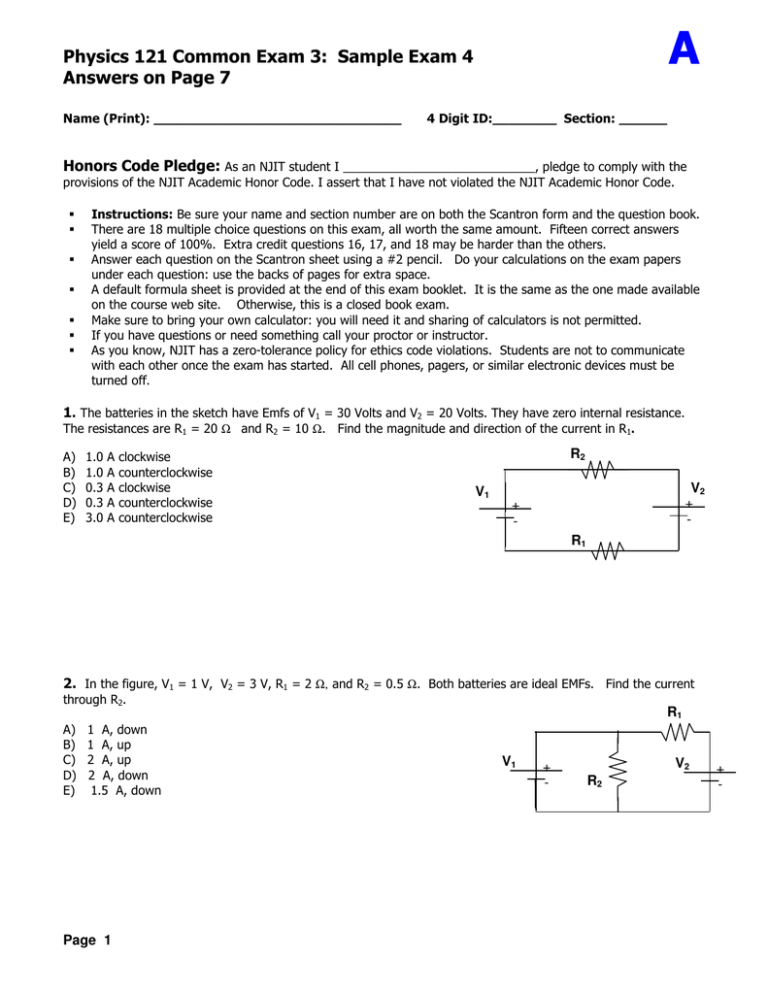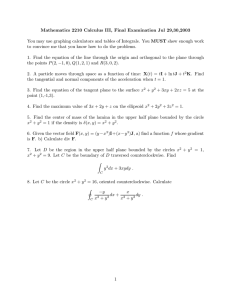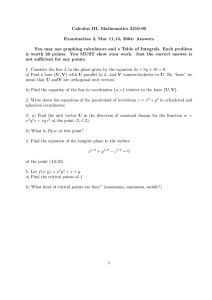Recent sample exam (#4) for common 3
advertisement

A Physics 121 Common Exam 3: Sample Exam 4 Answers on Page 7 Name (Print): _______________________________ 4 Digit ID:________ Section: ______ Honors Code Pledge: As an NJIT student I ____________________________, pledge to comply with the provisions of the NJIT Academic Honor Code. I assert that I have not violated the NJIT Academic Honor Code. Instructions: Be sure your name and section number are on both the Scantron form and the question book. There are 18 multiple choice questions on this exam, all worth the same amount. Fifteen correct answers yield a score of 100%. Extra credit questions 16, 17, and 18 may be harder than the others. Answer each question on the Scantron sheet using a #2 pencil. Do your calculations on the exam papers under each question: use the backs of pages for extra space. A default formula sheet is provided at the end of this exam booklet. It is the same as the one made available on the course web site. Otherwise, this is a closed book exam. Make sure to bring your own calculator: you will need it and sharing of calculators is not permitted. If you have questions or need something call your proctor or instructor. As you know, NJIT has a zero-tolerance policy for ethics code violations. Students are not to communicate with each other once the exam has started. All cell phones, pagers, or similar electronic devices must be turned off. 1. The batteries in the sketch have Emfs of V1 = 30 Volts and V2 = 20 Volts. They have zero internal resistance. The resistances are R1 = 20 Ω and R2 = 10 Ω. Find the magnitude and direction of the current in R1. A) B) C) D) E) 1.0 1.0 0.3 0.3 3.0 A A A A A clockwise counterclockwise clockwise counterclockwise counterclockwise R2 V1 V2 + - + R1 2. In the figure, V1 = 1 V, V2 = 3 V, R1 = 2 Ω, and R2 = 0.5 Ω. Both batteries are ideal EMFs. Find the current through R2. A) B) C) D) E) 1 A, down 1 A, up 2 A, up 2 A, down 1.5 A, down Page 1 R1 V1 + - V2 R2 + - 3. For the circuit of the previous problem find the current through the battery labeled V1 A) B) C) D) E) 1 A, up 1 A, down 2 A, down 2 A, up 1.5 A, down A 4. In a series RC circuit, the applied voltage E = 24 V., R = 26 MΩ, and C = 5 µF. The capacitor is initially uncharged. How long does it take for the charging current through the resistor to fall to 1% of its initial value after the switch is closed? Select the closest answer: A) 1 s B) 10 s C) 1 min D) 10 min E) 1 h 5. A 20 milli-Farad capacitor with a charge of 0.2 milli-Coulombs is discharged through a resistor of 13 kΩ. How long will it take for the voltage on the capacitor to drop to 10% of the initial value? Select the closest answer: A) 1 s B) 10 s C) 1 min D) 10 min E) 1 h Page 2 6. A fast positively charged particle, which moves from left to right in the plane of the page, enters a region of magnetic field which points directly into the page. The particle will: A) B) C) D) E) be deflected out of the plane of the page continue moving in a straight line, but will accelerate continue moving in a straight line, but will decelerate be deflected down, still in the plane of the page be deflected up, still in the plane of the page A 7. When a mixed beam of positive and negative particles (all moving in the plane of the page toward its top) enters a region of magnetic field, the positive particles deviate to the right from their straight path, while the negative particles deviate to the left. The direction of the magnetic field is A) B) C) D) E) out of the plane of the page into the plane of the page to the left, in the plane of the page to the right, in the plane of the page down, in the plane of the page 8. A positively charged particle (a proton) with charge +1.6 x 10-19 C is moving with at a velocity v = 106 m/s in the positive x direction. It is crossing a region in which a uniform magnetic field with B = 250 kilo-Teslas points in the negative y direction (1 Kilo-Tesla = 1000 Teslas). Find the force acting on the particle. A) B) C) D) E) 4.0 4.0 4.0 4.0 4.0 x x x x x 10-8 N, 10-8 N, 10-8 N, 10-8 N, 10-8 N, -x direction -z direction +z direction -y direction +y direction 9. The magnetic field is the same as in the previous problem , but the velocity vector of the proton is in the x-y plane with components (106 , 106, 0) m/s. Find the force acting on the particle: A) B) C) D) E) none of the other choices 3.0 x 10-8 N, -y direction 6.0 x 10-8 N, -x direction 5.0 x 10-8 N, +z direction 4.0 x 10-8 N, -z direction Page 3 10. A wire whose length L = 4 cm is placed in a uniform magnetic field of magnitude B = 1 T. which points out of the page. The wire carries a current of 2 A to the right in the plane of the page. What are the magnitude and direction of the force exerted on the wire by the magnetic field? A) B) C) D) E) 0. 16 N, out of the page 0.08 N, up in the plane of the page 0.08 N, down in the plane of the page 8 N, up in the plane of the page 8 N, down in the plane of the page 11. Find the frequency of and direction of revolution for a proton moving with a speed of 1x106 m/s in an uniform magnetic field of B = 1 milli-Tesla (1 Milli-Tesla = 10-3 Teslas). The frequency is the reciprocal of the period. The field points directly into the page, and the velocity of the proton is in the plane of the page. The mass of the proton is approximately 1.7x10-27 kg. The answer is closest to: A) 15 kHz, counterclockwise B) 15 kHz, clockwise C) 15 MHz, counterclockwise D) 15 MHz, clockwise E) there is no revolution – the particle proceeds in a straight line A 12. Two parallel wires are each 5 meters long. They are separated by a perpendicular distance of 1 cm and carry currents of 20 A. and 100 A. in the opposite directions. Find the interaction force between the wires: A) B) C) D) E) zero 0.2 N, attraction 0.2 N, repulsion 2 x 10-3 N, attraction 2 x 10-3 N, repulsion Page 4 13. In the sketch (not to scale) a long straight wire carries a vertical current I1 = 2A in the plane of the page. A square frame whose sides a = 0.5 cm is also in the plane of the page and to the right of the straight wire. It carries a counterclockwise current of I2 = 16A and is oriented parallel to the wire. Which of the following correctly describes the net force on the frame: a I1 a I2 A) the frame is repelled by the wire B) the frame is attracted to the wire C) the net force on the frame is zero, but there is a torque which attempts to turn it around a vertical axis D) the net force on the frame is zero, but there is a torque which attempts to turn it around a horizontal axis E) both the net force and torque are zero 14. A circular loop with radius r = 0.5 cm carries current of I = 9.42 A in the counterclockwise direction in the plane of the page. The magnetic field at the center of the loop is closest to (1 mT = 1 milli-Teslas = 10-3 Teslas): A) B) C) D) E) zero 0.0012 mT , left 0.0012 mT , right 1.2 mT , into the page 1.2 mT, out of the page I 15. A tightly wound solenoid has 50 turns of wire per centimeter. It carries a current of 10 A. Find the magnetic field at the center of the solenoid. A) 0.63 mT B) 0.0063 T C) 0.063 T D) 0.63 T E) 6.3 T Page 5 A Extra Credit: 16. Referring back to problem 13, calculate the magnitude of the force which acts on the frame if the distance from the straight wire to the closest side of the square is also 0.5 cm. The figure in problem 13 is NOT drawn to scale. A) B) C) D) E) 0N 3.2 x 1.6 x 3.2 x 1.6 x 10-6 N 10-6 N 10-3 N 10-3 N Problems 17 and 18 use the following diagram. A sheet of current extends to +infinity and –infinity along the x (horizontal) direction. The current flows out of the plane of the page (towards the viewer) and has zero thickness along the y (vertical) direction. The sheet could be made up of a set of very thin wires carrying current out of the page as indicated in the sketch. The amount of current per unit length along the x-direction (the linear current density) is λ = 0.05 A/m. - infinity……. …….+ infinity P 17. Find the direction of the magnetic field at point P, a distance y = 1 milli-meter below the plane that contains the sheet of current. The direction of the field is (Hint: use symmetry): A) B) C) D) E) perpendicular to the plane of the page up, parallel to the plane of the page down, parallel to the plane of the page left, parallel to the plane of the page right, parallel to the plane of the page 18. For the previous problem, calculate the magnitude of the field at P, using Ampere’s circulation theorem (Amperes Law) and a suitably chosen Amperian loop. A) B) C) D) E) 3.14 3.14 6.28 9.42 3.14 Page 6 x x x x x 10+9 T 10-8 T 10-8 T 10-8 T 104 T A ANSWER KEY – Physics 121 Common Exam 3, Sample Exam 4 1. 2. 3. 4. 5. 6. 7. 8. 9. 10. 11. 12. 13. 14. 15. 16. 17. 18. C D A D D E A B E C A C A E C B E B A Page 7



